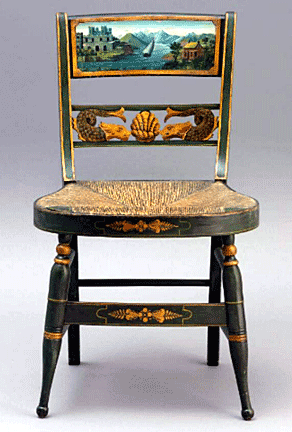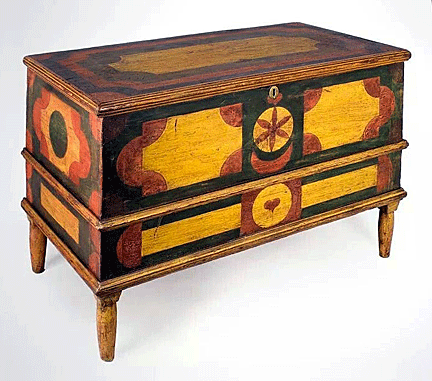|
Folk Art Furniture on
Parade
by Bob Brooke
 In
the 1960s, the trend was to strip antique furniture. Painted
furniture was out. Stripping down to the bare wood was the norm in
many cases. Gone were the colorful folk art motifs that decorated
many pieces. Unfortunately, with the encouragement of articles in
home decorating magazines, people stripped, then repainted worn
painted pieces, and finally “antiqued” them using antiquing kits.
Sounds illogical, and it was. In
the 1960s, the trend was to strip antique furniture. Painted
furniture was out. Stripping down to the bare wood was the norm in
many cases. Gone were the colorful folk art motifs that decorated
many pieces. Unfortunately, with the encouragement of articles in
home decorating magazines, people stripped, then repainted worn
painted pieces, and finally “antiqued” them using antiquing kits.
Sounds illogical, and it was.
Today, painted country pieces sell for high prices at antiques
shows, and city pieces--neoclassical chairs in the Hepplewhite
style, for instance--also are enjoying great popularity.
Along with the vogue for painted furniture has come the realization
that early American homes were full of color.

 The
peak of handcrafted folk art painted furniture ran from the 1790s to the
1880s. There weren’t any real art schools and not all that many fine
artists in the early 19th century. Many talented individuals became
commercial painters and worked with special skill on furniture, signs
and other useful objects. The
peak of handcrafted folk art painted furniture ran from the 1790s to the
1880s. There weren’t any real art schools and not all that many fine
artists in the early 19th century. Many talented individuals became
commercial painters and worked with special skill on furniture, signs
and other useful objects.
From the 1870s on, Mennonites from Poland, Russia and Prussia settled in
the Dakotas and Nebraska, bringing their tradition of grain painting on
light wood with them. The Mennonites decorated large wardrobes, dowry
chests, tables and sofas with these patterns, and also embellished
furniture with small floral motifs from the old country.
English cabinetmakers who settled in many parts of the country helped
spread the style for painted English neoclassical chairs based on the
designs of George Hepplewhite and Thomas Sheraton.
 But
the do-it-yourself idea, too, started early in the 19th century when
young girls learned how to paint furniture and wooden boxes with
watercolors. Cabinetmakers varnished the decorated pieces which featured
landscapes, figures, fruits, animals, and flowers. But
the do-it-yourself idea, too, started early in the 19th century when
young girls learned how to paint furniture and wooden boxes with
watercolors. Cabinetmakers varnished the decorated pieces which featured
landscapes, figures, fruits, animals, and flowers.
Itinerant painters and craftsmen lent their artistic expertise to the
production of painted furniture pieces such as chairs, settees,
armoires, cabinets, chests, benches, and other functional pieces. Many
of these were European emigrants who brought many distinct regional
styles and art forms to America.
By the early 20th Century, painted furniture began to have an impact on
American culture and design. Classified as folk art or peasant art,
these painted pieces became especially popular.
German Folk Furniture
 German
immigrants used furniture painted in the German folk style, such as
chairs, storage chests, tables, schranks, dressers, benches, and trunks.
German folk furniture was utility-based, simple country furniture that
remained significantly less influenced by the national and international
design trends. Painter decorators drew inspiration from local tastes,
preferences, history, culture, traditions, and heritage. Folk furniture
was handmade using elaborate joints, often involving painting and
carving to depict animals, scenes of daily life, geometric shapes,
bears, and birds. Furniture makers used locally available woods like
spruce, pine, beech, oak, birch, ash, and maple. German
immigrants used furniture painted in the German folk style, such as
chairs, storage chests, tables, schranks, dressers, benches, and trunks.
German folk furniture was utility-based, simple country furniture that
remained significantly less influenced by the national and international
design trends. Painter decorators drew inspiration from local tastes,
preferences, history, culture, traditions, and heritage. Folk furniture
was handmade using elaborate joints, often involving painting and
carving to depict animals, scenes of daily life, geometric shapes,
bears, and birds. Furniture makers used locally available woods like
spruce, pine, beech, oak, birch, ash, and maple.
As elsewhere in Europe, national and international art trends targeted
the wealthy. However, some elements filtered down to the provincial
regions, influencing the works, skills, and tastes of local artisans.
Since Germany had abundant forests, local artisans used a variety of
woods to produce unique furniture.

Most of these pieces were distinctive of a particular region and period.
Since Germany had a long and complicated history, the style and design
of German folk furniture items varied depending on a piece's period and
area of origin.
With the advent of the Renaissance in the early 16th-century, most
European nations saw significant changes in the design and style of
furniture. However, the cabinetmakers of provincial Germany remained
largely unaffected by the Renaissance, producing unique Gothic-style
furniture.
 The
Renaissance brought new forms of furniture, including the bridal trunk.
Bridal trunks became a standard throughout Europe. The provincial German
population would often personalized these bridal trunks with
hand-painted designs. The
Renaissance brought new forms of furniture, including the bridal trunk.
Bridal trunks became a standard throughout Europe. The provincial German
population would often personalized these bridal trunks with
hand-painted designs.
While cleaning a piece is fine, and so is stabilizing paint that’s
flaking so it won’t fall off, but pieces shouldn’t be stripped and
repainted. The pattern of wear is part of the history of the piece.
These days, thanks to the popularity of painted furniture in antiques
stores and the American penchant for moving, a piece from one section of
the country may turn up in another.
Scandinavian Folk Furniture
 As
with German folk furniture, its counterpart in Scandinavia was also made
by rural, untrained furniture makers. It consisted of primarily
practical pieces—chairs, tables, stools, and trunks— designed and
constructed for everyday use. However, local carpenters ignored
traditional rules of proportion. They used locally available wood, such
as oak, ash, pine, and elm. Since they didn’t know about polishing
surfaces, they often left wood untreated or finished it with oil or
simple wax. But some makers would custom paint decorations inspired by
nature and natural materials, as well as local culture and traditions. As
with German folk furniture, its counterpart in Scandinavia was also made
by rural, untrained furniture makers. It consisted of primarily
practical pieces—chairs, tables, stools, and trunks— designed and
constructed for everyday use. However, local carpenters ignored
traditional rules of proportion. They used locally available wood, such
as oak, ash, pine, and elm. Since they didn’t know about polishing
surfaces, they often left wood untreated or finished it with oil or
simple wax. But some makers would custom paint decorations inspired by
nature and natural materials, as well as local culture and traditions.
 Scandinavian
folk furniture tends to be simple in design with crude board and plank
construction. Carpenters used tapered, straight, turned, or cabriole
legs, joined with a stretcher. Tables were simple in design, consisting
of multiple boards resting on trestles or fixed to a joined frame
composed of four legs connected by stretchers. Scandinavian
folk furniture tends to be simple in design with crude board and plank
construction. Carpenters used tapered, straight, turned, or cabriole
legs, joined with a stretcher. Tables were simple in design, consisting
of multiple boards resting on trestles or fixed to a joined frame
composed of four legs connected by stretchers.
Rural Danish folk furniture makers employed darker woods, such as pine,
teak, and rosewood, which grew abundantly in Denmark, for their pieces.
The Danes also painted their furniture in bright and vivid colors.
Motifs of Danish folk furniture came from their surroundings—animals,
flowers, human figures, six-angular stars, and Biblical motifs.
Since ancient times,
Norwegian folk furniture had incorporated traditional motifs. Flowers,
birds, animals, trees, and plants, as well as geometric shapes,
decorated chests and trunks. When the elaborate Baroque and Rococo
styles infiltrated rural Norway, furniture became ornate and colorful.
During the 18th century, a decorative folk art, called Rosemaling,
originated in rural Norway..
Rosemaling could also be found in rural Sweden. Called “kurbitsmålning,”
derived from the word “kurbits," meaning "long-bodied gourd." The style
got its name from the depictions of gourds, flowers, and leaves that
decorated Swedish furniture between 1790 and 1850. Towards the
mid-18th-century and during the rule of Gustav III, the Swedish
furniture style became heavily influenced by the Greco-Roman style
because of discoveries made in the ruins of Pompeii and Herculaneum.

Rosemaling flourished from the 18th to the mid-19th century,
particularly in Norway. Originally used to decorate church walls and
ceilings. It then spread to wooden items commonly used in daily life,
such as ale bowls, stools, chairs, cupboards, boxes, and trunks. Using
stylized ornamentation made up of fantasy flowers, scrollwork, fine line
work, flowing patterns, and sometimes geometric elements, giving
Rosemaling its unique feel. Some paintings included landscapes and
architectural elements.
 Rosemaling
designs used "C" and "S" shaped brushstrokes that featured scroll and
flowing lines, floral designs, and both subtle and vibrant colors.
Script lettering, scenes, animal and human figures could also be
included. Rosemaling
designs used "C" and "S" shaped brushstrokes that featured scroll and
flowing lines, floral designs, and both subtle and vibrant colors.
Script lettering, scenes, animal and human figures could also be
included.
Artists who specialized in Rosemaling often traveled from county to
county painting churches, homes and furnishings for a commission of
either money or merely room and board, carrying Rosemaling over the
mountains and toward Norway's western coast. Once farther away from the
influence of the painters' guild in Oslo, these artists tried new ideas
and motifs. Rosemaling became widespread as amateur artists in rural
areas often imitated this folk art. Soon, three regional styles
developed—Telemark, Hallingdal and Rogaland—named after the regions in
which each originated.
 The
Telemark style of decoration consists of a root with branches and
flowers swirling out from it. Another popular style was Hallingdal which
differs from Telemark in its use of less translucent, bolder colored
paint. In addition, it had more symmetry and pattern. The Rogaland style
consisted of more floral images than lines or scrolls and often had
darker background with a central flower surrounded by leaves and other
decorations. The
Telemark style of decoration consists of a root with branches and
flowers swirling out from it. Another popular style was Hallingdal which
differs from Telemark in its use of less translucent, bolder colored
paint. In addition, it had more symmetry and pattern. The Rogaland style
consisted of more floral images than lines or scrolls and often had
darker background with a central flower surrounded by leaves and other
decorations.
What to Look For
Wear patterns and pigment fading or loss reveal a lot of information
about the authenticity and origin of a piece of painted folk furniture.
For instance, areas of a piece where other objects have come into
contact with it reveal information about the piece’s age and background.
The feet of a chest or the surface of a table show if a piece has been
repeatedly repositioned or cared for improperly. Look for signs of
abrasions, scratches, paint loss. Areas where hands may have touched a
piece and left a residue can help identify condition.

Palette colors also inform collectors about the regional background of a
painted piece of furniture. Certain colors may be connected to a
particular area of the world or regions of a country.
<
Back to More Antique Spotlights
Next
Article > |
